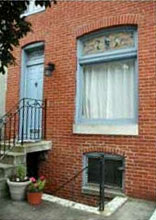
Important Contacts
Ridgely’s Architectural Review Committee
arc@ridgelysdelight.org
CHAP
417 E. Fayette St.,
8th floor
Baltimore, MD 21202
410-396-4866
Fax: 410-396-5662
Permits Office
417 E. Fayette St., Rm 100
Baltimore, MD 21202
410-396-3360
Forms
Application for Notice to Proceed
Historic Tax Credit Application
Small Project/Residential Permit Application
Ridgely's Delight's Historic Preservation Guidelines
Download as a PDF
Review the Approval Process
These guidelines are based on the city-wide guidelines published by CHAP and are tailored to the architecture of Ridgely’s Delight. The Ridgely’s Delight Association will support any plans that follow these guidelines at CHAP hearings or negotiations.
By law, CHAP must approve any of the following activities in Ridgely’s Delight:
- excavation, construction or erection of any building, fence, wall, or other structure of any kind
- removal of any external architectural feature
- reconstruction, alteration, change to exterior color by painting or other means
- demolition of any structure
CHAP’s approval is based upon the appropriateness of the proposed work. CHAP considers "the historic or architectural value and color of the exterior architectural features of other structures in the immediate neighborhood" when reviewing proposals.
General Considerations
Existing or Older Non-conforming Features
Windows, Doors, Roofs, Decks, & Other Common Changes
Major Projects: Demolition, Rehabilitations, & New Construction
Download PDF of the official guidelines
 Most of the structures in Ridgely’s Delight were built between the War of 1812 and the Civil War (1861-1865). To preserve the neighborhood for posterity, the historic district has two primary preservation goals:
Most of the structures in Ridgely’s Delight were built between the War of 1812 and the Civil War (1861-1865). To preserve the neighborhood for posterity, the historic district has two primary preservation goals:
- Maintain the neighborhood’s general historic look and feel. To do this, you must use historic architectural practices, building materials, and colors. A certain amount of change to individual structures is allowed to meet evolving needs and uses as long as you follow the guidelines.
- Preserve the neighborhood’s authenticity. Because Ridgely’s Delight is a real historic neighborhood, it is important to preserve original historic material when possible. Therefore, it is better to repair an old window than to replace it, it is better to use exact duplicate materials than substitutes, and it is better to avoid changes when they are not necessary. Since modern needs make this a more challenging goal, the guidelines can be more flexible in this regard.
Existing or Older Non-conforming Features
Anything built or installed before Ridgely’s Delight became an historic district in 1980 may be kept and maintained forever. Existing older additions, such as 1970s aluminum storm windows, etc., are grandfathered. However, when you need to change or replace these features, the new components or materials must follow the historic guidelines.
Windows, Doors, Roofs, Decks and Other Common Changes
These are the most common changes made by Ridgely’s Delight residents. I you are replacing windows, doors, or other typically wooden features, they must be of painted solid-wood construction. Synthetic materials like vinyl, plastic, and aluminum are prohibited.
 Windows: New windows must be made of painted wood, and must have at least as many separate panes as the originals. The panes must be separated by real structural mullions (the wood that divides the panes), not snap-in grilles or plastic interior dividers. Thermal glass is fine. Appropriate painted-wood thermal windows are available from better manufacturers like Marvin and Pella. Aluminum-clad windows are prohibited.
Windows: New windows must be made of painted wood, and must have at least as many separate panes as the originals. The panes must be separated by real structural mullions (the wood that divides the panes), not snap-in grilles or plastic interior dividers. Thermal glass is fine. Appropriate painted-wood thermal windows are available from better manufacturers like Marvin and Pella. Aluminum-clad windows are prohibited.
Doors: New doors must be of solid, painted wood, usually with six panels and no window, unless your building was once commercial or was built after 1870. Overhead transoms provide ample light, and a discreet peep-hole can give a secure view outside. Doors should be painted, not varnished or stained.
Doors may not:
- be metal-clad
- be flat or industrial in appearance
- have plastic components
If security is an issue, see the section on security gates below.
Back of the building: While the guidelines may sometimes be more flexible for parts of a structure that are hidden from view, CHAP’s rules cover a building's entire exterior. The rear and side view are often as important as the front, and sometimes more so. While public views are a priority, neighbors’ views are also important. If your proposal affects a neighbor’s view, you should get a letter of support from him or her for a CHAP hearing.
Roofs: The original roof shape must be preserved. For steeply pitched roofs, standard shingles or standing-rib metal are acceptable. If the roof is visible from the front, the shingle color should look like slate or weathered wood. Modern materials can be used on flat or hidden roofs.
Front steps: Steps can be made of wood, brick, marble or cast concrete. Wood steps must be painted to match the structure’s trim. Cast concrete steps should be simple and unpainted. New iron railings must be simple and subtle.
Decks: Decks are not historic features. However, discreet decks may be added in back in the style of traditional porches or verandahs. This means painted-wood construction, simple railings with balusters, and preferably a roof. Unpainted, pressure-treated decks are not approved, and no deck can be visible from the front of a structure.
 Security gates and window bars: Iron window bars and open bar security doors are allowed. Bars should not be ornate or decorative because they were not original features. Glass storm or security doors are not approved.
Security gates and window bars: Iron window bars and open bar security doors are allowed. Bars should not be ornate or decorative because they were not original features. Glass storm or security doors are not approved.
Window screens and screen doors: Window screens and screen doors must have painted wood frames, and they must perfectly fit the window and door openings. Aluminum or vinyl screens are not permitted.
Fences and garden walls: Rear fences should be of plain wood plank construction, and they may be unfinished, whitewashed, or painted. They should not be fancy or include lattice. Front fences should generally be made of wrought iron. Garden walls are an important architectural feature, and should be preserved, if possible. Baltimore city code does not allow any fence or garden wall taller than 6 feet.
Sandblasting and re-pointing brickwork: Sandblasting destroys the hard outer surface of bricks, and is no longer permitted. It is better to chemically clean paint or dirt from masonry. Use a blade grinder of appropriate width when re-pointing; widening the pointing will ruin the brick and destroy the masonry’s historic character. Avoid Portland cement-based mortars. Lime mortar preserves antique soft-fired brick best.
Commercial signs: Signs may be simple or fanciful. Hand-painted, 19th century-style wooden signs are best. Signs may be externally lit. Neon, internally-illuminated, flashing, or other gaudy signs are prohibited.
Modern mechanical components: Satellite dishes, central A/C units, and other modern services must be installed in the least obvious location possible, usually on the roof or rear of a building.
Major Projects: Demolition, Rehabilitations and New Construction 
All major projects are unique, and their approval requires case-by-case review. Most major projects require a public CHAP hearing. In these cases, details can be negotiated based on practical and historic issues. If details are approved for unique projects, it does not mean that they will be approved for similar projects.
Demolition: Demolition of an historic building is a last option, and will only be allowed to protect public safety or to help rescue other historic resources. Demolition permits will not be granted simply to expedite a project or to make one more profitable. All demolition requests require public hearings. The Ridgely’s Delight Association will support CHAP in prosecuting owners who willfully allow their historic buildings to fall into disrepair to expedite demolition. This civil crime is defined as demolition by neglect.
Additions and major alterations: Exterior additions and major changes must be simple and functional, must complement the existing structure, and should not draw undue attention to themselves. The change in function must have the least possible effect on the appearance. Changes and additions should be reversible if possible, allowing historic buildings to return to their original configuration in the future.
New construction: New buildings in the historic district must support the existing architectural style in scale, proportion, materials, and color. New buildings may reflect their own age, but should not clearly look like earlier architectural styles, and they should not clash with or draw attention away from the rest of the neighborhood.
Share this site.
Photos ©Joanne Drummond. All rights reserved. Reproduction or downloading without permission is prohibited and is a violation of federal law.

